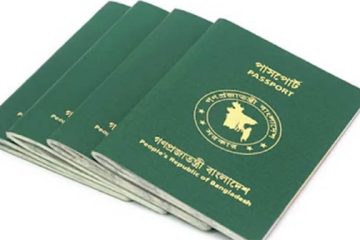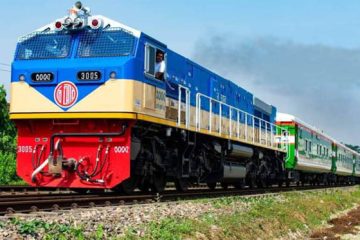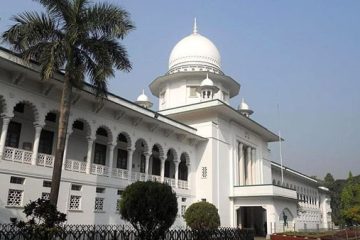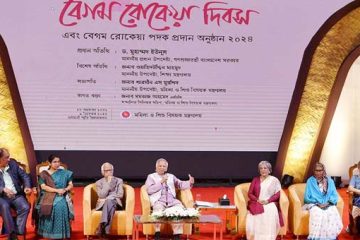Dr. M.A. BASHAR
Ecosystem itself is the phenomenon of interaction between biotic and abiotic factors in the nature. Man becomes victim of environmental disasters or environmental degradation at the community level. It is obvious that environmental soundness must be ensured at the micro level. Then it is possible to maintain at the community level. We see scientifically that a single species of the butterfly like the birdwing can play a great role in the questions of species richness and species assemblage in an ecosystem. In the year 2011, three hundred and fifty birdwing butterflies are found in Satchari forest in Bangladesh belonging to the two species. Though the term ‘census’ is used to apply for an official enumeration of population with statistics relating to them, but it is mainly applicable for the case of humans, the Homo Sapiens. It is rarely used for the cases of counting population of any insects. Human population enumeration is easier enumerate an insect population in a certain area. Man knows almost all activity-patterns and movement-styles of the humans. Relating to the insects, ethological aspects are always very hard to assess the mode of activities and movements. An insect population census renders multidimensional studies to assess the behavioural aspects first, and then to go for innovating a system to count its population. I have tried for about ten years long only to find out an interactive relation-pattern of birdwing butterflies with their related plants (especially the host plant) in a forest area in the wild state. It is necessary to say that, the birdwing butterflies have got tremendous rhythmic interactions with their host plant, host plant’s phenology and with abiotic factors in their surroundings. Our wild-state forest experiments strongly support that acquiring knowledge on ethological aspects of the butterflies could statistically identify the procedures to be adopted for counting butterflies in an ecosystem, especially in a forest ecosystem.
Very recently the EBBL, department of zoology, University of Dhaka has innovated a device to count interactive population of butterflies in the forest ecosystem. This technique is named as ‘Biotic-epicentre method’. This method has been used for estimating butterfly population in forest ecosystem in the wild state. Butterfly-plant interaction in a forest ecosystem is actually the dynamic key factor that determines the status of a forest. This theory has been made evidential by the EBBL researchers through various experiments. Presently the researchers in a team work have successfully made a population census of birdwing butterflies in Satchari (greater Sylhet district) forest by using their newly innovated method the “Biotic-epicntre technical”. This method deals with two important points for practicing it in the field condition and in the wild state. These are ethological aspects of the birdwings: use of key plant population-sites as epicentre; and application of epicentre-spot-design: counting application for individuals of the target butterfly.
The most of the butterflies are strictly phytophagous in character in their larval stage. That they are host specific to plant almost in all the cases. This means that each of the species lay eggs on its selected plant only where its larval stage can develop through taking food from the host plant-parts.
Birdwings are the largest butterflies in the world. The biggest species Ornithopterus is found in Indonesia. The birdwings are very beautiful butterflies. They are liked by everybody for their decorative colouration and charismatic activities with flowers. But their role in the maintenance of ecosystem is poorly known and their role in the question of forest-health status determination has not been analysed yet. Birdwings are highly interactive with their host-plants’ phenology, distribution, seasonality and fruitification. These charismatic behaviours render the birdwings to establish their colonisation in the forest keeping the host-plant’s distribution as ‘epicentre’. Sustenance–strategy of association between the epicentre and the butterfly mobility has been utilised for counting the birdwings’ population in the present context. The counting process has been treated by giving name of the method as “Biotic-epicentre method’. Let us see what happens on the ethological aspects of the birdwings in the forest ecosystem and how we can utilise the ethological behaviours of the butterflies to count their population which is very much important in the question of forest status determination.
In the context of butterfly-plant interactions, two aspects (plants and animals) come together to act as a single factor to be acted with abiotic factors in an area. And that is why, in an ecosystem plant-animal interaction stands as a major and vital part. This functional part is dependent on the question of “species richness and species assemblage” in an area of the biosphere. Some animals are found to play a very vital role in the sustenance of such species richness and species assemblage. This is occurred in nature by showing their characteristic behaviours and activities. The EBBL has carried out some experiments on the fact of the interaction between the two biotic aspects (the plants and animals). The lab has found some important and interesting information on the question of functioning of forest ecosystem. The researchers also obtained some information on sustenance of forest ecosystem’s health. Very recently, it is found that the birdwings can create a situation for (ecological condition) generating species assemblage and species richness in the forest.
There are only two birdwings in Bangladesh. They are seriously threatened species in the country. Almost in all the forests of Bangladesh, the birdwings have lost their host plant together with other supporting plants. In these forests they are no more found to survive. The butterflies are totally absent in all the north-eastern and north-western forests of Bangladesh. Only in very limited forests of the south-eastern region of the country they are still surviving with strong hardship. In the forests of Eid-ghar, Eid-gaon, medhkachabia, Fashia khali, Ringvang, Chunati, Tangabati, Karerhat, Mir Sarai, and Sitakunda in the district of greater Chittagong the birdwings have not seen after 2005. With strong hardship they are still surviving in the forests of Lawachara, Chautali, Nurjahan, Anaras bari, Madhappur, and Barshiganj in the greater Sylhet district. Only the birdwings population is found to survive the forests of Rama-Kalenga and Satchari forest areas. It is to be said with evidence that the population of the largest butterflies (birdwings) is going to disappeared within 5-7 years even in the forests other than the forests of Satchari and Rama-Kalenga. Proper scientific measures are to be taken immediately. It is alarming that even in the above two forest areas depletion of the host plants and the related/supportive plants is going very fast. Above situation encouraged for modelling a study programme to innovate population estimate method for the largest butterflies of the country.
Biotic-epicentre
Biotic-epicentre is a permanent place or site in natural ecosystem for interactive floral and faunal species assemblage with rhythmic occurrence. In this place host plant species remains as principal source-factor for the target animals. In the present case the target animal is an insect. This plant species by its life cycle style is surrounded and supported by many other plant species. This process of surroundings and supporting make an association of species composition. The species composition creates characteristic vegetative-hedge. The vegetative-hedge looks like a typical ‘cluster’ of trees, vines, climbers and undergrowth plants in the forests. The vegetative hedge-size varies, disappears or reappears in its permanent place in relation with seasonal changes in the year. In our case, the host plant spreads with noticeable appearance and jubilancy during the summer season. In the winter the plant remains in dormancy when vegetative parts (leaves specially) disappear; only roots and stems are remained with dead-like appearance. At the beginning of the summer vegetative propagation starts in the forest at the respective places. During the propagation time, interactive activities between the host plants and the butterflies go in full swing. The interactive activities include appearance of new stems, new leaves, increase of leaves and arrival of reproductive stage that make suitable sites for egg-layings. The appeared plant-parts provide suitable food resource for larval development of the butterflies. For existence of the strong phenomenon of interaction between the host plant and the birdwing butterflies, the butterflies make visit rhythmically to the host plants area. Such situation creates territorial character for the respective butterfly to the host plant hedge area. This host-plant hedge area is treated as the biotic epicentre in the present text. The rhythmic visit to the host-hedge area by the butterflies create field for counting the population of the butterflies. The method of counting has been titled as the “biotic-epicentre method” for estimating butterfly population in the forest ecosystem.
In analysing the biotic-epicentre method for butterfly population census in Satchari forest some important stages need to go through. We faced to know the life-stages (phenology) and their variations in relation to the seasonality of the host (target) plant in the wild state. At the same time we had to know about the life cycle of the butterflies (birdwings) whose population count was envisaged to materialise. Coincidences between the life-stages of the host plant and the life-stages of the butterflies were considered as the key factors to carry out the ‘biotic-epicentre method’ application. We have emphasised on the ethological aspects of the butterflies and the phenological aspects of the host plants; and their vegetative hedge-formation in the forest where the study was conducted.
Interaction between butterflies and host plant
As the birdwings are very much specific on their host plant selection, they are habituated to be confined in the certain forest area. They are characterised in maintaining of special life style. These butterflies are large-bodied and comparatively slow fliers but almost restless in the morning half of the day. Generally in the mid-day they remain in “resting” under the shade trees. They do not feed on all flowers found in the vicinity of their host-plant. Only some selective plant-flowers provide them suitable structure and nectar storage. The flowers are visited by the butterflies in the morning and evening. The plant-flowers visited by the butterflies are entomophilous and pollination in them is carried out by the butterflies.
The birdwings pass through four stages to complete their life cycle. The egg, larva, pupa and adult stage. The birdwing butterflies are called poison-eaters, as their larval stages have to depend on such specific plants as food sources which contain poison like aristolochic acid I and aristolochic acid II. The larva cannot develop on any other plants. These plants are called host plants. The birdwings have different life-stages; similarly the host plants have different life stages like seedling stage, vegetative stage, pre-flowering stage, reproductive stage, fruitification stage, maturing stage and the post maturing stage. In the insect, the life-stages are known as phases of life cycle and the stages in the plants are called phenological stages.
There is a synchronisation of coincidences between the life stages of the insects (birdwings) and the phenological stages of their host plants in the wild state. Both (the plant and the animals) are wild organisms. It happens that, these butterflies are found only in some selected forests in Bangladesh as their host plants and other related (nectar and shelter) plants are found thereby only. These plants are seriously endangered almost in the all forests of the country. This coincidence of synchronisation between two biotic factors in ‘dynamic situation’ is the key factor to keep a forest healthy and make it sustainable. Very recently the EBBL University of Dhaka has identified the fact of ‘dynamic situation’ in the forest ecosystems. The present write-up deals with the fact.
As it is already told, the host plant of birdwings is wild and grows in the forests. The host plant habitat (where it grows) always stands as an association of other different plant species. The habitat of the host plant requires a special condition in the forest as not to be disturbed at least by the humans. The plant population needs about ten to fifteen other plant species for their healthy survival in nature. It needs four/five species of vines associated with it; different cane species to protect it from the disastrous calamities; different kinds of canopy trees for its strong support to get the top height in the forest vegetation (as the butterfly does not lay eggs on the low height in the forest vegetation); and in its habitat needs very large trees like chapalish (Artocarpus chaplasha) and jam tree (Syzygium cumini) to be shaded by them from direct sunlight. The host plant does not grow well under direct sunlight. They are very touchy in nature.
Birdwings are not very swift fliers. They are selective to the few plants for nectar collection, and also selective to have only a few plants as shelter plants during unusual hours in the day or in the varied climatic conditions. They need very selective nectar plants in the adult stage for survival. On the other hand, they are habituated to maintain territory around their host plant population. So the nectar plants should have their distribution and abundance in the vicinity of the host populations.
The birdwings need strong species assemblage of the wild plants in a forest ecosystem as their host plants, nectar plants and shelter plants. These three different types of plant species they need to survive themselves in good condition in nature. On the other hand, the birdwings play a great role in the question of plant pollination and also in the fact of gene-flow activities in the plant population, especially in the forest ecosystem. They are confined on the especial types of plants for their life-style maintenance. Consequently, the flora and fauna are ensured to have their well-established habitat ensemble. This habitat-establishment (combination and dynamism of life-stages of the plant and butterflies) makes an epicentre for the butterflies. Considering the interactive behaviours of butterflies with the host plant phenology a population estimation method has been innovated. Let us see how we have utilised the habitat of biotic combinations as ‘biotic-epicentre’ for counting population practically.
The study-envisage and the tenure
The EBBL has started to do research on the biodiversity conservation in 1991 and on the butterflies and their association with plant in the wild state was started in 1998. But the study on the subject stated in the present text was intensively taken under experimentation from the year- 2006. Since then serious study has been continuing on the subject of host plants- finding and their seasonal variation together with the phenological changes. It is to be noted that, seed germination in the forest for the case of the birdwings’ host plants is rarely seen. Propagation from the persisted earlier plants is usual and very common in the forests; and that is why vegetative-hedge formation is noticeable in the summer season. During such propagating and growing stage, the butterflies are found to rhythmically visit host plant-vegetative-hedge. This rhythmicity comprised some ethological behaviours of the butterflies. These are pre-mating behaviour, courtship behaviour, mating behaviour, foraging behaviour, egg-laying behaviour and egg-laying support searching, sheltering behaviour and lastly the territorial behaviour and activities. To specify the behaviours isolately and to find out their interactive strategies with stages of the host plant, we have spent four years and more time in the experimentation. The EBBL has made some procedural frame-work designating each of the vegetative-hedge as different sized “transect” on the basis of the vegetative-hedge bed which has been called before as “biotic-epicentre”.
Population count
The count of population was made by using fifteen different biotic-epicentres. They were selected as “spot of practice” on the basis of presence of indicator plant species (specially attractive wild plant to the birdwings) in hedge formation. Each of the biotic-epicentres was specified with respective serial number starting from 1 to 15. The used plant species is the host-plant for the target butterflies. It was used as the target plant species in the population count procedure. The hedge formation was found to appear naturally as the assemblage of some commensalistic vines together with other big trees keeping the target plant (host plant) as a centre for the procedure.
Seven (7) different types of field-sampling designed models (nomenclatured area) are used under the heading of “Transect”. They are followed as Transect I, II, III, IV, V, VI, and transect VII. Each transect may have one biotic epicentre or more than one biotic epicentres. Each biotic epicentre is provided with one or more host-plant-hedge together with all other associated plants.
Each of the nomenclatured “transect” area was characterised with the size and number of host plant- hedge/hedges in the biotic-epicentres which constituted the transect. Detailed characters of the transects and biotic-epicentres are not taken here for description, but inclusion of their serial numbers and names are given on the basis of host plant-hedge vegetation together with host plant-association.
In the nomenclature of transects, serial no. I of the designed transect is known as “Rectangular sampling transect”. This transect was constituted with three biotic-epicentres (12, 13 and 14). In the triangular transect, biotic-epicentres were provided with large trees associated with host plant and supportive vines. Serial number II transect is known as “Indicator-plant- epicentre circular transect” which included three biotic-epicentres also (6, 7 and 11). This transect dealt with host plant-hedge epicentre having identified circular area. Transect serial III is known as “Roadside longitudinal transect”. This is composed of two biotic-epicentres (1 and 8) and deals with single epicentre-hedge in its central position. The length-wise transects are characteristically situated at the roadside. The serial number IV transect is named as “Slope-zigzag odd plain transect” having several epicentres of the host plant hedge/hedges in a lengthy area with irregular shape. The zigzag transect composed of two biotic-epicentres (2 and 5). Serial number V is called “Triangular odd-plain transect”. It contains a single biotic-epicentre (9) of host plant-hedge situated in the centre of the triangular area. The VI serial transect known as “Top-hill circular transect”. It has several hedges of host plant in circularly placed pattern around the top hill designed area. The circular area has been selected at top of a hill in the forest with single number of biotic-epicentre (15). Transect serial number VII is called “Vulnerable asymmetric transect”. It is most irregular shaped area having three biotic-epicentres (3, 4 and 10). This transect always appears in the asymmetric and irregular shapes.
A formula known as “EBBL-formula” has been formulated and was applied for the estimation of birdwing population in Satchari forest area. The formula is EP=R1+R2/n. Where EP stands for ‘estimated population’; R1 stands for results of first calculation; R1 stands for results of second calculation; and n stands for number of calculations. It is to be noted that, R1 is summation of the calculated results from primary observations; and R2 is the summation of the calculated results from secondary observations. The two observations’ results were accumulated under detail calculation by using the formula. The full calculation procedure has not been described here. Only the results-accumulation is presented. In the calculation, R1-value was found as 210; and R2-value as 420. n-value was 2. According to our formula it stands that EP= 210+420/2 = 630/2 = 315. Therefore, population estimated in the experimental (in the Satchari forest) area is 315. In the study period (year 2011) the birdwings populatin of the forest is 315. It is important to note that, in our study period ecological conditions and seasonal optimisation were most suitable for population availability. The coincidental synchronisation between host-plant phenology and the target butterflies’ life stages was preferable.
Population estimation study for the birdwings is very important in the question of maintenance of forest healthiness. The count produces a key factor for advancing in the forest status determination and environmental soundness measurement. It is already told in my written statements in the dailies that, the birdwings are very important butterflies which contribute a lot in the field of forest ecosystem enhancement and as a biotic-indicator for measuring impact of climatic change on biodiversity conservation and biodiversity sustenance
Article originally published on The Independent
Dr. M.A. BASHAR is a Professor and former Dean, Department of Zoology, Faculty of Biological Sciences, University of Dhaka




















